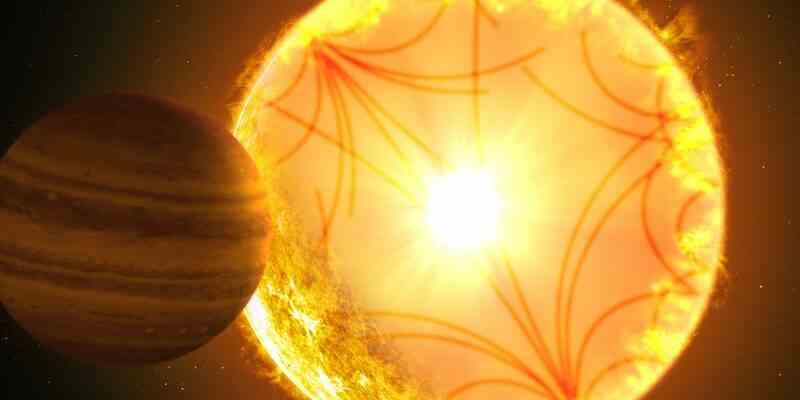A cosmic catastrophe is looming 2600 light-years from Earth: the “hot Jupiter” type planet Kepler-1658b is spiraling towards its star and will collapse into it in about 2.5 million years. This is shown by observations by a research team from the USA and Great Britain. It is the first time such a death spiral has been detected on a planet from an old, advanced star. According to the scientists, the observation also provides an insight into the future of our solar system in the journal Astrophysical Journal Letters.
“We have previously found evidence of planets spiraling toward their stars,” said Shreyas Vissapragada of the Harvard Smithsonian Center for Astrophysics. “But we have never been able to detect this phenomenon on a planet of a highly developed star.” Such stars have already used up most of their nuclear energy supply and are beginning to expand into a red giant star. Our sun will reach this stage in about five billion years.
However, these stars, the theory goes, should be particularly effective at pulling planets in tight orbits ever closer – until they eventually fall into the star. That should be the case for Kepler-1658b, a Jupiter-sized gaseous planet in an extremely close orbit around its star: its orbital period is just 3.8 days and its distance from the star is only one-eighth of the distance between Mercury and the Sun.
The planet is moving faster and faster, getting closer to its star
To detect any change in this orbit, Vassapragada and his colleagues evaluated observations from the Kepler and Tess space telescopes and the Palomar Observatory’s Hale telescope from 2009 to 2022. As seen from Earth, Kepler-1658b regularly passes in front of its star, slightly dimming its brightness as it does so. Measuring these transits provides astronomers with the planet’s orbital period immediately. And an observation over a longer period of time should show whether the orbital period is changing.
However, that sounds easier than it is. Because such changes are very slow. However, with the help of a complex analysis procedure, the team was able to determine a decrease in the orbital period of 131 milliseconds per year. A decrease in the orbital period means: The planet moves faster and faster and approaches the star in a spiral. Vissapragada and his colleagues calculate that it will take about 2.5 million years for Kepler-1658b to finally crash into the star.
The cause of the impending cosmic catastrophe are the tidal forces that the star and planet exert on each other at such a small distance. Something similar happens in the earth-moon system: the tides generated by the moon on earth slow down the earth’s rotation – and because of the physical law of conservation of angular momentum, the moon must therefore move further and further away from the earth. If an orbit is very narrow – as in the case of Kepler-1658b – this effect is reversed and thus leads to an inward spiral orbit.
However, the tidal interaction is complex in detail and also depends, for example, on the internal structure of the celestial bodies. Theoretical models suggest that highly developed stars are particularly effective at accelerating planets into a death spiral. “We now have, for the first time, an example of a planet spiraling around an evolved star, and we can use it to improve our models for tidal physics,” Vissapragada points out. “So for us, Kepler-1658 is a kind of cosmic laboratory – and with a little luck we can find many more such systems.”

